-
Preserving Squash and a Terrific Pumpkin Chai Recipe!

Beautiful patterns on the banana squash shell. Four sugar baby pumpkins that I’d kept for myself, and three pink banana squash, were all in need of preservation. They were not keeping well due to the warmth of our hot San Diego county Fall. During a rainy break in the weather I did something about it. You can preserve cooked pumpkin and winter squash best by freezing it. If you have a pressure canner you may can pureed pumpkin or pumpkin pieces in liquid, but since I only use the water bath method that wasn’t an option.

Even sugar baby pumpkins can be difficult to cut when raw. There’s a better way! Roasting a squash isn’t difficult at all. In fact, you only have to wash it, put it on a tray in a 350F oven for about an hour (longer if its a really large pumpkin), and then slice when cooled.

Roasting a whole pumpkin makes the scooping so easy! Its easy to scrape out the seeds and then spoon out the cooked flesh out of the hardened shell. This is what I did for the sugar baby pumpkins. There was too much banana squash to fit whole into the oven, however, so I cut them into chunks, scooped out the seeds, covered them with aluminum foil (it helps steam them) and baked 350F for forty-five minutes.
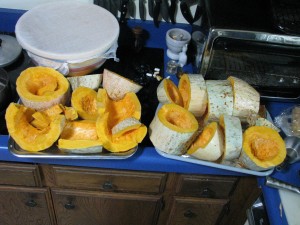
Three banana squash is a lot of squash I have more details here. I also roasted the pumpkin seeds.
Then I had a lot of squash to puree! These squash and pumpkins were dry, so I added a little water to the VitaMix and tossed in the chunks.
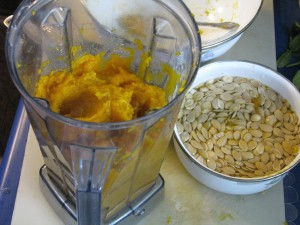
Pumpkin and seeds. I pureed batches until smooth, then spooned cups full into freezer bags. My pumpkin scone recipe calls for only half a cup, so I froze one-cup batches, as well as two-cup batches for pie. The secret to ‘vacuum-packing’ freezer bags is to close the top of the bag around a straw and then suck all the air out. It really works well, and is kind of fun, too.

Get a straw, suck out the air and presto: vacuum packed! However, the best thing that happened out of all this squashing was that I had a little less than a cup of pureed roasted squash left in the VitaMix, too little to freeze and really irritating to scoop out. It was a cold day and past lunchtime. I had an idea and spooned in what was left of some Chai tea mix, poured in vanilla soy milk, blended it until it warmed up and sat down to drink. Heaven! I’m not one for pumpkin flavored things, but this was the real deal.
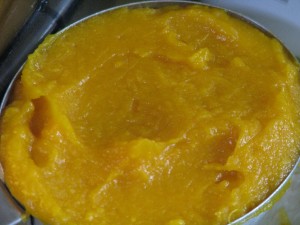
Pumpkin puree. It was so good that the next day I took a cup of the pureed squash that I refrigerated, poured in 1 1/2 cups of vanilla soy milk, a touch of orange syrup left over from candying orange peel, added cinnamon and blended until it was hot. It was thick, satisfying, a little sweet, spicy and full of beta carotene, fiber, protein and other good things. I’m sure you can do the same thing with canned pumpkin and other liquids, such as milk, rice milk, almond milk or coconut milk. If fact, I insist that you try it.

Hot Yum! Pumpkin ChaiAuthor: Diane C. KennedyRecipe type: BeverageCuisine: AmericanPrep time:Cook time:Total time:Serves: 2Cold or hot, spiced pureed pumpkin or squash mixed with the milk of your choice is extreme comfort food that is actually terrific for you!Ingredients- 1 cup cooked pumpkin or squash puree, fresh or canned.
- 1½ - 2 cups vanilla soy milk, or milk of your choice. (Less for a thick drink).
- ½ - ¾ teaspoon cinnamon, pumpkin pie spice or up to 1 scoop Chai tea mix.
- Sweetener (optional); a natural syrup would do or honey.
- ½ teaspoon vanilla (optional)
Instructions- For cold pumpkin chai mix all ingredients briefly in a blender or VitaMix.
- Taste to adjust seasonings, thickness and sweetener, and serve.
- For hot pumpkin chai, heat milk and add to the rest of the ingredients in a blender and process. If you have a VitaMix, you can add all cold ingredients and then process until it is hot.
I’m going to make some more for me right now. -
Home Remedies
I’ve been going to physical therapy for my sprained wrist, and fortunately the therapist is someone who believes in diet and herbs as a viable alternative to or complement of conventional medicine, as do I. We started discussing home cures, and I began to think over how many that I knew because my mother used them. I was born when my parents were in their early forties, and they were born before the 1920’s, before World War II and the scientific revolution. Before everyone turned to petri dishes for the ultimate answers. Medicine made great progress in finding vaccines for heartbreaking diseases such as polio. However, its successes gave it a blanket approval, and suddenly scientists could do no wrong. Many medicines are derived from plants, such as simple aspirin which has the main ingredient salicin that is found in willow trees. Scientists found a way to synthesize salicin so as to put a patent on it and make money, just like so many other drugs. When pharmaceutical companies took hold, that is when we lost control of our traditional medicine and our health. Health is a business, and what is in the drug stores has little to do with getting well, but is mostly about making money. Most medicines treat symptoms and provide enough relief to make you re-buy the product, but won’t eliminate it because then you will have no need to buy it again.
Home remedies have for the most part become lost in the past as post World War II parents disregarded the ‘old fashioned’ methods and turned to the pharmacy. Thus, the traditions were not passed on to their children, so the remedies have been lost. Only in reading old books do we hear them mentioned. Or we can surreptitiously inquire at a health food store, where much of the same buying tactics are at play, and clerks are not medical professionals. The desperation for cures is such that people would often believe strangers rather than doctors, well-written propaganda rather than documented success, and that is dangerous. I was shopping at Henry’s last week, standing with my empty basket looking at the herbal tinctures section, and a woman pops around the corner and holds up a bottle of sesame oil and asks if it would be a good choice to use as a carrier oil for a tincture she had at home. Fortunately for her, I’ve been involved with herbs for thirty years, and I knew what she was talking about, and gave her I think accurate advice and warnings, which included doing some sound Internet research on her own. I don’t know how a short, middle-aged woman with an empty shopping basket would appear to be knowledgeable, but perhaps anyone would have done as well for her.
I have been researching home remedies for reducing inflammation, since my sprained wrist hasn’t healed and I have arthritis and bursitis (wow… just bury me now! What happened to youth?) among other casualties of the physical working life. It made me think of my mother and all the vitamins she gave us and home remedies, as well as enforcing a healthy, balanced diet when meat and potatoes were the standard.
One cure she passed on from her European grandmothers was the mustard plaster for chest colds. Mix dry mustard powder with water to make a paste, put it on an old cloth and slap it on your chest. She used old diaper cloths. I still have them! If you have tender skin or are a child, then a film of vegetable oil on the skin helps protect from the burn. I believe that the way it works is to stimulate blood flow to help the body clear up congestion, and warm up the body to help sweat out the toxins. Capsicum from peppers works the same way in arthritis medicines. Vicks Vaporub replaced the mustard plaster, using menthol from eucalyptus and mints (now synthesized) to clear the sinuses as well as help the chest. The petroleum jelly in it links us to our dependence on oil, whereas mustard grows in most places and people would harvest the weeds, using the fresh leaves for a spring tonic and the seeds for food and the mustard plaster. Another remedy was blackberry juice for.. um… the ‘runs’. It ‘binds’ the intestines quickly. She’d use a little Manischewitz Blackberry Brandy diluted in warm water, and it would not only stop the problem, but relieve the cramps and make a sick kid sleep. I’ve always used it and it has always worked, as well as plain blackberry juice. Some blackberry brandys don’t have real juice in them, so beware. There is also the cider vinegar and honey remedy which was very popular in the late 1960’s, and has cyclical resurgences. Cider vinegar is slightly fermented from apples and should have a murky, stringy bit in the bottle. That is the ‘mother’ part of the yeast which is alive, and which you can use to ferment other things if you make your own. It is also claimed to be very healthy. Mom would give us apple cider vinegar mixed with honey and warm water to drink along with dinner. I have a fondness for it, even though it brings me back to a childhood which I would rather forget. Every now and then I read about how great vinegar is and mix some up. In fact, I think I’ll do so today and see if it helps with my wrist!
Let’s see what else… prunes for.., well, the opposite of what blackberry is for. Ginger ale to settle a stomach when throwing up. The carbonation helps, but it is mostly the ginger, which eases car sickness, morning sickness, or a sour stomach. Of course, garlic, which is the cure-all to many illnesses it seems. I figure that people reeked so badly of garlic that no one would get close enough to them to give them any germs. Then there is arnica for bruises. Arnica cream is a standard in my medicine cabinet (you can learn more about them here), and when my daughter reminded me of it this week and I started applying it to my wrist at night, I had a noticeable difference in the morning. Honey for many things, including local honey for hayfever, applying it to dry skin, using it for its germicidal properties, and mixed with lemon for coughs. Raw, unheated honey kills germs and bacteria. When people had dirt floors they used strewing herbs such as rosemary and lavender on the ground when. Not only did they help with the smells of the household (which were considerable), they had medicinal properties. Rosemary kills germs. In my research for anti-inflammatory herbs, along with some Asian herbs that I’m unfamiliar with and probably can’t get, the four main common ones are garlic, ginger, pepper and turmeric. Turmeric is a yellow powder from the turmeric root and is used in curries here, but used in many medicines in India. I’m planning on creating a tincture of the four of them and applying it to my wrist to see what happens.
Of course there is always the simple Irish remedy, as is hailed on one of our traditional Irish music CD’s: ‘Have a drink of whiskey to soothe away your pains’.
If you have proven home remedies, I’d love to hear about them!
-
How To Make Decaf Tea That Doesn’t Taste Like Dishwater
Okay, okay, this is an off-the-wall topic for many people. Its raining (a good thing), and hot tea is right there at the top of my list after an hour’s vigorous exercise at the Fallbrook Community Center’s Fitness Fusion Class. Actually, a cuppa is often on my mind. In fact, whenever I hear someone mention tea, I crave it. Hot, with honey. If I’m sick, then honey and lemon. If I’m REALLY sick, then honey, lemon and a shot of whiskey. If I’m feeling low, honey and fat-free half-and-half. If I’m REALLY low, then honey and cream. (Rice milk can do the trick, too.)

My sister and I used to brew up herbal teas when I was in my teens, reading about the medicinal value of each plant, according to this mint tea review mixing and matching can do wonders. I remember how Shephard’s Purse was particularly soothing. Since I never liked the taste of coffee (it makes me gag!), I took to black teas. A few years ago my dentist commented on how overly developed my jaw muscles were, and said that I probably ground my teeth when I slept. that is when I consulted Daytona Beach periodontist. It turned out that the caffeine in my one or two cups of tea a day acted like an amplifier for the usual stress and worry that comes with being alive. Like an alcoholic in denial I boasted that I could do with or without caffeine. Any ol’ time.
Sure.
I went off caffeine and for several days had the jitters, was even crankier than normal, and went through withdrawl. From a twice-a-day cuppa habit! It worked. When the caffeine was flushed from my system, the clenching stopped, the grinding stopped, and I became more stable in my energy levels during the day. That two o’clock droop disappeared. That was about three years ago, and now if I have caffeine I can feel it speeding up my heart rate, prickling along the back of my neck, and making my jaws clench. Yes, I’m sensitive to drugs of any kind, so perhaps this isn’t the normal person’s reaction, but for some I think it’s significant.
But what about my treasured cuppa? My daughter (who was also lectured by the dentist) and I switched to decaf tea. Ick. Brown sweetened water. We tried bulk decaf tea with better success, but it still was ick. Then my brilliant daughter came up with the most important part of the secret of a decent cuppa decaf tea, and I figured out a little more. And finally, here it is:
Whether you use a teabag or bulk decaf tea, make sure that it is fresh. Use freshly boiling hot water. If you use water that has already been heated and cooled, the oxygen has mostly bubbled out of it and the tea will be flat. Swish hot water in your cup to warm it, just like you’d do with a pot of tea, and dump it out. (This also removes any dust that may have settled, or creatures that have taken refuge there.) (I’m only partially kidding.) Put in your tea or teabag and pour just enough boiling water in to cover the tea. DO NOT FILL IT UP YET. That’s my daughter’s brilliant trick. Somehow the steeping in a small amount of boiling water intensifies the brewing and really imparts flavor. Here’s my addition: cover the cup to keep the heat in. You can used one of those teacups that comes with a strainer and lid, or use the saucer, or any borrowed lid.
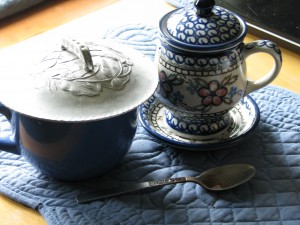
The cover keeps the heat in, and keeps the tea brewing at the same rate; if water cools, it doesn’t brew very well. After all, you aren’t making Sun Tea here. Steep for about three minutes this way. Then reboil some water. I have a Proctor Silex electric water pot with a thermostatic shut-off that I bought at K-Mart and I love it. I just turn the switch back on. Its amazing how cool water gets when sitting for just a few minutes. Fill the cup up with more boiling water, re-cover the cup, and let it steep for a few more minutes. Then, voila! Uncover a pretty decent-flavored cup of decaf tea. At this point add in anything you want in it: sweetener, cream, whiskey, lemon…. Don’t add anything during the steeping time because it inhibits the steeping.
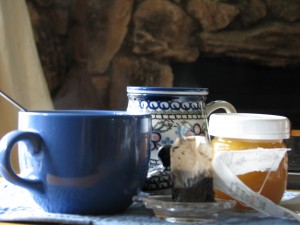
So, in a nutshell, use fresh, boiled water. Just cover the tea with water. Cover the cup and steep for a few minutes. Pour in the rest of the water which is boiling. Cover the cup and steep for a few more minutes. Uncover and add in stuff or don’t add in stuff. Enjoy and give up clenching forever. Of course, tea goes better with toast smeared with some of that lemon curd from the previous post.
Why couldn’t I have said all that right at the beginning? Geez….. 🙂